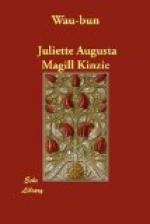When the fishing-party reached Lee’s Place, it was proposed to stop and warn the inmates to be upon their guard, as the signal from the fort indicated danger of some kind. All was still as death around the house. They groped their way along, and as the corporal jumped over the small enclosure he placed his hand upon the dead body of a man. By the sense of touch he soon ascertained that the head was without a scalp, and otherwise mutilated. The faithful dog of the murdered man stood guarding the lifeless remains of his master.
The tale was now told. The men retreated to their canoes, and reached the fort unmolested about eleven o’clock at night. The next morning a party of the citizens and soldiers volunteered to go to Lee’s Place, to learn further the fate of its occupants. The body of Mr. White was found pierced by two balls, and with eleven stabs in the breast. The Frenchman, as already described, lay dead, with his dog still beside him. Their bodies were brought to the fort and buried in its immediate vicinity.
It was subsequently ascertained, from traders out in the Indian country, that the perpetrators of this bloody deed were a party of Winnebagoes, who had come into this neighborhood to “take some white scalps.” Their plan had been, to proceed down the river from Lee’s Place, and kill every white man without the walls of the fort. Hearing, however, the report of the cannon, and not knowing what it portended, they thought it best to remain satisfied with this one exploit, and forthwith retreated to their homes on Rock River.
The inhabitants outside the fort, consisting of a few discharged soldiers and some families of half-breeds, now intrenched themselves in the Agency House. This stood west of the fort, between the pickets and the river, and distant about twenty rods from the former.
It was an old-fashioned log building, with a hall running through the centre, and one large room on each side. Piazzas extended the whole length of the building in front and rear. These were planked up, for greater security, port-holes were cut, and sentinels posted at night.
As the enemy were believed to be lurking still in the neighborhood, or, emboldened by former success, likely to return at any moment, an order was issued prohibiting any soldier or citizen from leaving the vicinity of the garrison without a guard.
One night a sergeant and private, who were out on a patrol, came suddenly upon a party of Indians in the pasture adjoining the esplanade. The sergeant fired his piece, and both retreated towards the fort. Before they could reach it, an Indian threw his tomahawk, which missed the sergeant and struck a wagon standing near. The sentinel from the block-house immediately fired, and with effect, while the men got safely in. The next morning it was ascertained, from traces of blood to a considerable distance into the prairie, and from the appearance of a body having been laid among the long grass, that some execution had been done.




